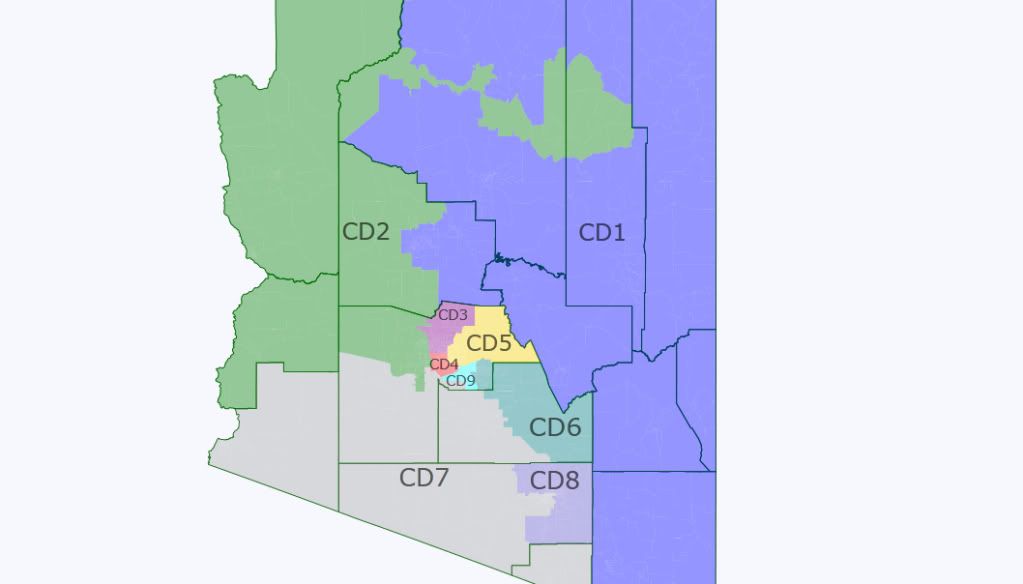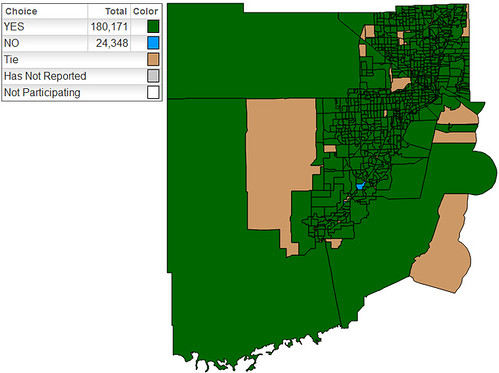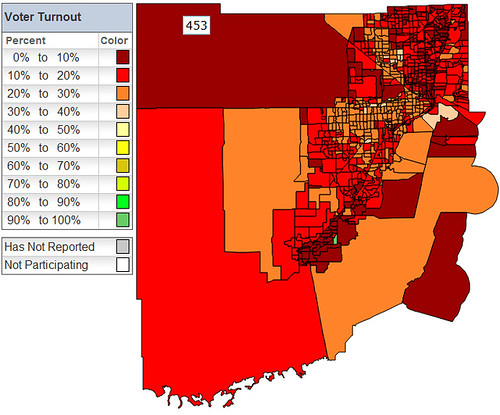• NM-Sen (PDF): What happens if you took a poll and no one answered? That’s what this Tulchin Research poll (taken on behalf of the Defenders of Wildlife) feels like to me, what with its sample size of just 213 likely Democratic primary voters. If you’re trying to figure out the margin of error, you’ll need to start counting on your other hand – it’s 6.7%. Anyhow, the results, such as they are: 1st CD Rep. Martin Heinrich: 32; Lt. Gov. Diane Denish: 25; 3rd CD Rep. Ben Ray Luján’s: 15; State Auditor Hector Balderas: 5; and 24% undecided. I think it’s very unlikely that the field would develop this way, but I still think these “round up the usual suspects” polls can be valuable – if they have enough respondents, that is.
• OH-Sen: This kind of speculation is always seriously moronic… but hey, I live to serve. So in case you want to imagine a world where the Republican presidential nominee wins next year, and he’s picked Sen. Rob Portman as his running mate, Roll Call is happy to indulge your grim dystopian fantasy about a suddenly open Senate seat in Ohio come Jan. 20, 2013.
• WV-Gov: Democratic State House Speaker Rick Thompson just earned the endorsement of two teachers’ unions: The West Virginia Federation of Teachers and the West Virginia Education Association. The primary here for this oddly-timed special election (necessary because of ex-Gov. Joe Manchin’s Senate victory last year) is coming up very soon, May 14th.
• CT-05: Kevin Rennie mentions a couple of possible Democratic prospects to replace Rep. Chris Murphy, who of course is running for Senate. One is 28-year-old pr strategist Dan Roberti, whose father Vincent was once a state rep. The other is CNBC reporter and former local news anchor Brian Schactman.
• NV-02: A piece in the WaPo has 2006 and 2008 Dem nominee Jill Derby sounding pretty interested – she said she’s considering forming an exploratory committee. (Ridiculous as that sounds – I mean, she’s considering whether to consider? – that actually counts as pretty aggressive talk in this hyper-cautious age.) The story also mentions another possible name, Assemblywoman Debbie Smith, as well as noting that state Treasurer Kate Marshall (whom we flagged as another potential candidate yesterday) calling the race “absolutely winnable.”
• NY-26: Republican Jane Corwin has her first ad out (NWOTSOTB), in which she repeatedly touts her supposed small business credentials but doesn’t mention that she’s a Republican. In some not-so-happy news, New York’s Green Party is saying they are likely to endorse Ian Murphy, the guy behind the fake David Koch call to WI Gov. Scott Walker, as their nominee. That means they probably won’t cross-endorse whoever winds up being the Democratic nominee… and that signals a long four years ahead of us. (Thanks to scoring 50,000 votes in last year’s gubernatorial election, the Greens get an automatic ballot spot in every race in the state through 2016.) Green Party co-chair Peter LaVenia says he doesn’t think that Murphy will “siphon votes” from the Dem… oy, christ, this is giving me nightmarish flashbacks to debates with idiotic Naderites in 2000. I can’t do this again.
• Wisconsin Recall: Let’s talk about Randy Hopper. If you’ll click the link, you can hear a ridiculously misleading radio ad that he’s just gone up with. The lying isn’t the point – it’s the fact that he’s on the defensive, a place you never want to be. And he knows, it, too – which is why he’s gone out and hired Jeff Harvey, who most recently managed Rep. Dave Reichert’s (WA-08) successful campaign last year. That’s a pretty big gun to bring in to a state lege race, so how can Hopper afford something like that? Well, state Senate Majority Leader Scott Fitzgerald and several lackeys (including recall target Alberta Darling) were in DC last night, picking up cash at a high-dollar fundraiser held at Haley Barbour’s lobbying firm (more-or-less in exchange for gunning through that infamous bit of right-to-work legislation). The optics couldn’t be better! But cold, sweet cash can move mountains.
In related news, HuffPo’s Sam Stein tries to track down elusive information about the state of the attempted recalls of Democratic senators. It sounds like it’s going poorly: An uncoordinated mess by different groups which launched different efforts at different times. The Wisconsin Republican Party has refused to get involved, and apparently the recall has been whittled down to just three target senators (from the original eight). I would not be hugely surprised if they would up with zero.
• Philly Mayor: This is pretty funny: Philadelphia Mayor Michael Nutter faces no real primary opposition, but he’s still trying to bounce the crazy brother of former Mayor John Street, Milton, from the ballot. Among other things, Nutter is alleging that Street doesn’t meet the residency requirements, which say that candidates have to live in the city for three years prior to the election. Where was Street? Serving a 30-month sentence in federal prison on tax evasion charges – in Kentucky.
• SF Mayor: SurveyUSA has a poll out for the San Francisco mayoral race slated for this November. SF uses instant run-off voting (IRV), so SUSA asked people to pick their first, second, and third choices. Interim Mayor Ed Lee (who filled in for Gavin Newsom when he won the Lt. Gov. race last fall) says he isn’t running but actually gets the most first-choice votes. Here’s the full field:
Ed Lee, interim Mayor, 17%
Michaela Alioto-Pier, former Board of Supervisors member, 12%
Leeland Yee, State Senator, 11%
David Chiu, Board of Supervisors President, 10%
Dennis Herrera, City Attorney, 9%
Bevan Dufty, former Supervisor, 8%
Click through the link to see second and third choices.
• DCCC: Steve Israel talked a bunch with the Hotline about candidate recruitment. The most interesting thing is his “alumni association” of former members of Congress who are thinking about running again. He holds “semi-regular” (Hotline’s phrase) conference calls with “the vast majority of former members.” Israel says that in recent weeks, interest and attendance has spiked, and I have to guess that recent Democratic enthusiasm inspired heavily by protests in the Midwest has been a factor. Israel also insists that ex-MoCs who have closed down their campaign accounts or taken lobbying jobs are not necessarily taking themselves out of the game; he sympathetically argues that some folks simply need the cash. Of course, optics aside, K Street might just seem a lot more comfortable than the campaign trail grind to many of these folks
• DNC: The usual unnamed Democrats are telling Politico they think Ted Strickland is a “strong contender” to replace Tim Kaine at the DNC if the latter decides to run for the Senate in Virginia. I think the world of Strickland, but I’d hate to see his considerable talents get muzzled at the DNC. I just don’t think that a proud populist is going to be able to speak his mind while at the Obama DNC.
• Votes: Dave Catanese has a run-down on the House members seeking (or likely to seek) statewide office and how they voted on the most recent temporary budget bill. A big swath of Republicans voted “no” (i.e., against their party), after having previously voted for the prior continuing resolution, likely out of fears of getting teabagger (because the bills don’t cut spending enough). Meanwhile, several Democrats in the same boat all voted “yes.”
• WATN?: My word:
A seven-count indictment accuses Tom Ganley, a high-profile auto dealer and onetime congressional candidate, of kidnapping a 39-year-old Cleveland woman and having sexual contact with her.
Ganley, 68, faces three felony charges of gross sexual imposition, and single counts of kidnapping, abduction, solicitation, and menacing by stalking, according to Ryan Miday, a spokesman for County Prosecutor Bill Mason.
Redistricting Roundup:
• Mississippi: Looks like Lt. Gov. and gubernatorial aspirant Phil Bryant is getting his ass handed to him. Bryant attempted to interfere with the state Senate’s attempt to draw a new map by instead offering his own. Bryant’s plan was rejected by the Senate (which we noted on Tuesday). Now, the Senate’s original plan has been adopted by the House. So it looks like an incumbent-protection deal has been reached, with the Democratic-held House and the Republican-controlled Senate each getting their way. But even with a Dem gerrymander, you’ve got to believe it’s only a matter of time before the House falls, too.
• General: Politico has a piece discussing the GOP’s overall strategy of playing it safe with redistricting this decade, and to avoid “dummymanders” like the one in Pennsylvania which proved (at least temporarily) disastrous to the party.
















